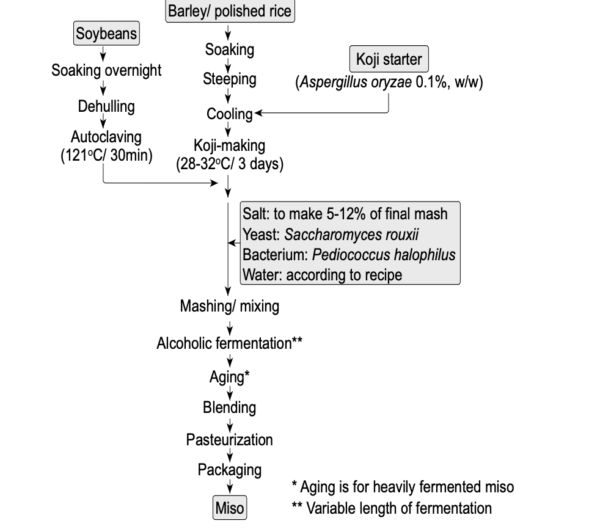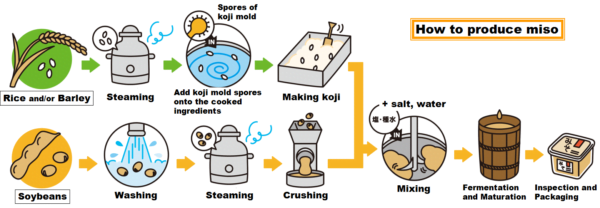Miso, a smooth and luscious paste brought forth through the collaboration of molds, yeasts, and bacteria in a symphony of soybeans, barley or rye, and rice, narrates a tale of both flavor enhancement and nourishment. The process of Miso preparation, its benefits and harmful effects will be discussed in this article.
- Miso is a paste-like, salty dish from Japan, made through fermentation using molds, yeasts, and bacteria from a mix of soybeans, barley or rye, and rice.
- It serves as both a seasoning and a traditional Japanese food staple, commonly used in morning soups.
- It has a pleasant aroma resembling soy sauce, and certain types, especially with higher soybean content and longer fermentation, can have a meat-like flavor.
- Various types of miso exist in Japan, including kome miso (rice miso), sendai miso, mame miso, shinshu miso, and edo miso.
- It comes in different colors ranging from light white to reddish brown.
- White miso is favored in western Japan due to its pale color, sweet flavor, low salt concentration (5-6%), and quick fermentation (about seven days at 23-33°C).
- Edo miso, popular in Tokyo, is reddish brown, has lower salt content, and takes two weeks to ferment.
- The amount of soybeans in the mix influences salt content and fermentation duration.
- It typically contains 45-50% moisture, 4.5-13% salt, 4-11% fat, and 4-38% reducing sugars.
- Its pH level ranges from 5 to 5.4.
Commercial Preparation Method of Miso
Key components: Soybeans (yellow variety preferred), polished rice, rye or barley, salt, and alcohol.

Preparation of Rice/Barley
- Soaking process: Barley/polished rice soaked in large fiberglass or epoxy-lined steel tanks (1000 kg+) for around 17 hours.
- Continuous conveyance: Material conveyed on stainless steel mesh belts through tunnel steamers.
- Steam introduction: Steam introduced at 4.3 and 3.5 psig in first and second chambers respectively.
- Starch elimination: Partially cooked rice/barley rinsed to remove free starch during transfer.
Koji Preparation
- Inoculation: Rice/barley inoculated with Aspergillus oryzae spores for proteases, amylases, lipases, and enzyme generation.
- Inoculation rate: Inoculation rate set at 0.1% (w/w), approximately 109 spores/gram.
Fermentation of Koji
- Temperature and time: Koji fermented for 3 days at 28-32°C in specialized rooms, agitated drums, or rectangular tanks.
- Aerobic phase: Fermentation process indicates aerobic phase of production.
- Rotating drums: Drums (1.8m diameter, 3.6m length) with temperature, humidity, and air flow controls. Finger projections inside break forming pattern.
Fermentation Conclusion and Mold Management
- Fermentation result: Rice/barley covered with white mycelia, emitting sweet, pleasant aroma
- Mold control: Mold development stopped before sporulation through anaerobic brine fermentation, cooling, or mixing with 30% salt.
Soybean Preparation
- Hydration process: Cleaned soybeans soaked overnight in large tanks, expanding to twice their weight.
- Dehulling options: Dehulled dry (burr mill) or wet (abrasive mechanical peeler) based on utilization.
- Cooking techniques: Batch-type or continuous cookers (retorts/autoclaves) with steam or water at 121°C for 30-40 minutes or higher temperature equivalents.
Mashing/Mixing/Preparing Green Miso
- Ingredient fusion: Cooked beans mashed and mixed with koji, supplemented with salt.
- Inoculation with cultures: Mixture inoculated with miso or pure cultures of yeasts (Saccharomyces rouxii, Torulopsis) and bacteria (Pediococcus halophilus, Streptococcus fecalis).
- Green miso formation: Resulting mixture known as green miso, characterized by acidity from bacteria and alcohol from yeasts.
Anaerobic Fermentation
- Transfer and fermentation: Paste transferred to temperature-controlled tanks or vats (up to 12000 kg).
- Fermentation process: Carried out in anaerobic conditions, yielding varying flavors, colors, and textures based on salt ratios and fermentation duration.
Fermentation Duration and Conclusion
- Duration range: Fermentation time varies from 1 week (white miso) to 2 years (mame miso).
- Post-fermentation steps: Blending, pasteurization, addition of 2% alcohol, and unit packaging in plastic bags.
Aging for Heavily Fermented Miso
- Aging process: Heavily fermented miso can be aged by allowing it to stand at room temperature for approximately two weeks before pasteurization.

Health Benefits of Miso Consumption
It has been consumed for centuries and is known for its unique flavor and potential health benefits. Some of the health benefits include:
Probiotic properties: It is a fermented food, which means it contains beneficial bacteria that can support gut health. These probiotics can contribute to a balanced gut microbiome, which is important for digestion, immune function, and overall well-being.
Nutrient rich: They include a variety of nutrients, including vitamins (B vitamins, vitamin K), minerals (manganese, zinc, and copper), and protein. It’s also high in fiber and antioxidants.
Cancer prevention: Some studies suggest that its consumption may lower the risk of developing some forms of cancer, including breast, prostate, and colon cancer. This potential benefit is hypothesized to be associated with the isoflavones and antioxidants contained.
Heart health: It includes components that can help in the reduction of blood pressure and the risk of heart disease. Miso includes isoflavones, which are considered to contribute to its heart-protective effects.
Bone health: It contains vitamin K, which is important for bone health and may help enhance bone density. Furthermore, the fermentation process improves the bioavailability of elements vital for bone health, such as calcium and magnesium.
Digestive health: It contains probiotics, which can help with digestive health by promoting a healthy balance of bacteria in the intestines. This can aid in digestion and alleviate gastrointestinal issues.
Antioxidant activity: It includes antioxidants such phenolic compounds, which help protect cells from oxidative stress and may aid with general health and disease prevention.
Harmful effects of Miso
Sodium content: Miso has a high sodium content due to the fermentation process and the addition of salt. Excess salt consumption can lead to high blood pressure, cardiovascular problems, and water retention. Individuals with hypertension or other salt-sensitive conditions should consume carefully and manage their overall sodium consumption.
Allergies and Sensitivities: Miso is generally manufactured from soybeans, one of the most common allergens. People who are sensitive to soy should avoid miso or use soy-free variants derived from other legumes. Furthermore, some people may be sensitive to the fermenting process or other chemicals, resulting in stomach pain or allergic reactions.
Tyramine Content: Fermented foods, such as miso, might have greater amounts of tyramine, a compound that can cause migraines or headaches in people who are sensitive to it.
Risk of Contaminants: There is a slight possibility of contamination during the fermentation process, as with any fermented or cultured product. It’s important to purchase them from reputable sources and ensure proper storage to minimize this risk.
Purine Content: Purines are naturally occurring chemicals that may be converted down into uric acid in the body. Gout, a painful type of arthritis, can be increased by high uric acid levels. People with gout or a history of gout attacks should consume in moderation.
References
- Hagiwara, S., Iizuka, M., Matsuo, T., & Yamashita, M. (2019). Miso: Benefits, Types, and Preparation Procedure. Journal of Food Science, 84(2), 179-188.
- An, H. M., Baek, E. H., Jang, S., Lee, D. K., & Kim, M. J. (2021). Potential Health Benefits of Miso and Mechanisms of Its Anticancer Activity: A Review. Nutrients, 13(8), 2632.
- Nekola, M. (2002). Miso – A traditional Japanese food. Department of Botany, Faculty of Science, Masaryk University.
- Japan External Trade Organization (JETRO). (2021). Miso and Shoyu: Traditional Fermented Soybean Seasonings.
- Nishiyama, Y., & Nakatani, Y. (1996). Characterization of Volatile Flavor Compounds in White Miso. Journal of Agricultural and Food Chemistry, 44(12), 3921-3925.
- Pelczar, M. J., Chan, E. C. S., & Krieg, N. R. (1982). Essentials of Industrial Microbiology. McGraw-Hill Education.